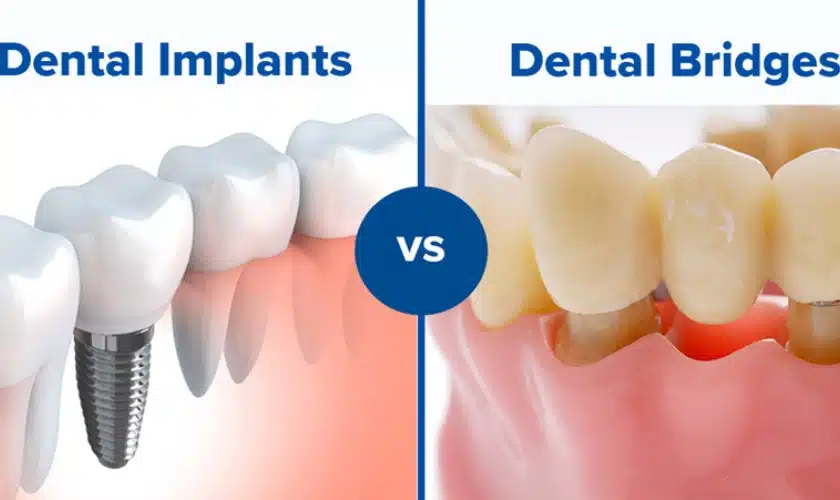In this blog post, we will explore the world of dental implants and dental bridges, highlighting their importance in replacing missing teeth. If you have experienced tooth loss and are unsure which option is right for you, we are here to provide all the necessary information. We will discuss the benefits, procedures, recovery processes, and candidate suitability for both dental implants and dental bridges, empowering you to make an informed decision about your oral health.
Dental Implants:
Consultation and Evaluation
Schedule a consultation with your Cosmetic dentist or surgeon to evaluate your oral health and consider X-rays or CT scans to determine if you are a suitable candidate for dental implants.
Treatment Planning –
A tailored treatment plan for dental implants is created based on a candidate’s needs, including implant number, restoration type, and any additional procedures like bone grafting or sinus augmentation.
Implant Placement
Surgical placement of dental implants, typically performed under local anesthesia or sedation, inserts a small titanium post into the jawbone, serving as an artificial tooth root.
Osseointegration
Osseointegration occurs after implant placement, where the jawbone fuses with the titanium implants, providing a stable foundation for the replacement teeth, typically taking several months.
Abutment Placement
After osseointegration, an abutment is attached to the implant, serving as a connector between the implant and the final restoration, allowing for the attachment of a replacement tooth or bridge.
Final Restoration
The final restoration, whether a crown or bridge, is custom-made to match the natural color, shape, and size of the teeth, resulting in a seamless, natural-looking smile.
Follow-up and Maintenance
Regular check-ups and maintenance appointments with your Cosmetic dentist and proper oral hygiene practices are crucial for the longevity and success of dental implants post-treatment.
Consult your dentist or oral surgeon to determine if dental implants are the right solution for replacing missing teeth, ensuring a permanent and durable solution.
Dental Bridges:
Evaluation and Treatment Planning
Schedule a dental bridge consultation with your dentist to evaluate oral health, assess remaining teeth, and determine the best option, possibly using X-rays or impressions.
Tooth Preparation
A dental bridge is prepared by reshaping adjacent abutment teeth to accommodate dental crowns or dental implants, depending on the presence of healthy adjacent teeth.
Impression and Temporary Bridge
After preparing abutment teeth, impressions are taken and sent to a dental laboratory for a custom-made dental bridge. A temporary bridge is placed to protect exposed teeth and gums.
Bridge Placement
After preparing the final bridge, the cosmetic dentist will check its fit and alignment, make adjustments if needed, and bond it using dental cement or adhesive.
Bite Adjustment and Final Checks
After securing the bridge, your cosmetic dentist will assess your bite for alignment, make minor adjustments for comfort, and check your speech for optimal function.
Follow-up and Maintenance
Maintaining good oral hygiene, scheduling regular check-ups, and cleanings around your dental bridge are crucial to prevent issues like gum disease and decay, as advised by your cosmetic dentist.
By following these steps, you can successfully restore your smile and improve your ability to chew and speak with a dental bridge. Remember to consult with your dentist to determine if a dental bridge is the right option for you based on your individual oral health needs and goals.
Comparison:
Cost: Dental implants are generally more expensive upfront compared to dental bridges, as they involve surgical procedures and the placement of individual implants. Dental bridges are typically a more affordable option.
Durability: Dental implants are well-known for their strength and endurance; with proper care, they may last a lifetime. Dental bridges, on the other hand, may need to be replaced after 10-15 years.
Procedure: Dental implant placement requires a surgical procedure, including the placement of titanium posts into the jawbone and a healing period for osseointegration. Dental bridges, while non-surgical, require tooth preparation and the placement of crowns on adjacent teeth.
Maintenance: Dental implants require regular brushing, flossing, and routine dental check-ups, similar to natural teeth. Dental bridges require extra care, including the use of floss threaders or special brushes to clean underneath the bridge.
Aesthetics: Dental implants offer a more natural-looking and seamless appearance, as they are individually placed and mimic the function and appearance of natural teeth. Dental bridges can also provide aesthetic benefits, but the presence of adjacent crowns may be noticeable.
Impact on Surrounding Teeth: Dental implants do not rely on adjacent teeth for support, whereas dental bridges require the support of neighboring healthy teeth. This means that dental implants have no impact on surrounding teeth, while bridges may require the alteration of healthy teeth.
By considering these points, you can make an informed decision about which option – dental implants or dental bridges – aligns best with your needs, budget, and overall oral health. Remember, it is always advisable to consult with a cosmetic dentist to receive personalized recommendations based on your specific situation.
Both dental implants and dental bridges have their advantages and considerations. We have discussed the benefits, procedures, recovery processes, and candidate suitability for each option. It’s crucial to consult with a cosmetic dentist to receive personalized recommendations based on your specific situation. Your dentist will thoroughly evaluate your dental health and help you choose the best solution for replacing missing teeth. Take your time seeking professional advice to regain your confident smile and optimal oral health. Now you have the complete outline for your blog post on dental implants vs. dental bridges. Fill in the details under each section, and you’ll have an informative and comprehensive article that will guide readers in making the right choice for their dental needs.
